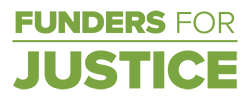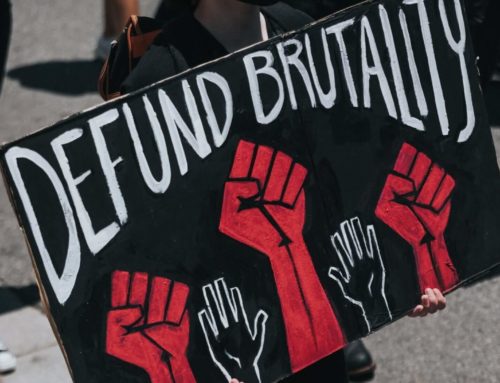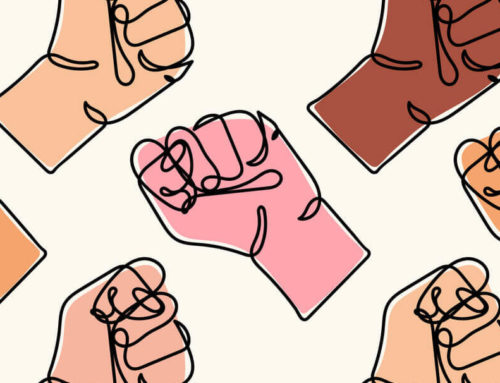by Cara Page & Eesha Pandit
March 25, 2020
The essay below was written by Cara Page and Eesha Pandit, who are part of the Funders for Justice community, and urges us to hold this moment for movement & philanthropists to understand what led us here and explore opportunities towards transforming our futures.
Opportunity for A New Frame
This moment asks us to consider how we might pivot and adapt in a way that centers collective care, safety, and protection for each other. This is a good time to re-examine our relationship with vulnerability. Many of us are feeling vulnerable ourselves, while naming communities that require particular care and are more susceptible to COVID-19, including our elders and people living with long term chronic illness. This is an opportunity to deepen our understanding of vulnerability, dis/ability, and chronic illness, at both the individual and structural level. Many of us are now thinking about accessibility and the goods and services we do and do not have access to today. As writer and disability justice activist Mia Mingus says, “accessibility is concrete resistance to the isolation of disabled people.” Now, when many of us are facing isolation for the first time, we must align ourselves in meaningful social and structural ways with people living with disabilities and deepen our political work to ensure that an understanding of ableism impacts all our movements for justice.
Perhaps most prescient in this call from disability justice advocates is a reminder of our interdependency. Many of us are facing the realization that the “myth of independence” is truly just that, and that we cannot sustain ourselves and our communities alone. We cannot meet all our needs alone. We cannot stay safe alone. At this moment, a public health crisis is creating social, medical, and political trauma that is awakening many of us to the fact our health, safety and well-being are interconnected whether we are in a global health crisis or not. This understanding is the basis of so much work for disability and healing justice, and it is a perfect moment to listen and learn from those organizers. We see many communities building care and mutual aid networks, which is something to consider for both the short and long term haul in the context of increased global fascism and climate change. As we continue to name all the ways our communities are connected and interdependent, it is our work now to name and identify the ways that movements for justice are, as well.
This creates a powerful moment for a transformative justice and healing justice frameworks to permeate our work. As powerfully named in the Astraea Healing Justice Report, “healing justice is a response to this trauma, lifting up practices that support resilience, wellness, safety and security as a necessary part of organizing and movement work. This increases the strength and long-term sustainability of our movements.”
This moment is a call to action, a call to slowing down and reconfiguring what is important, listening deeply to what communities are asking for, in the short and long term. It is vital to be mindful of what is urgent and why, and how this urgency impacts the people we work with and will care for and protect each other towards our future.
Perspective and Context
Sitting amidst the chaos of COVID-19, it is difficult to get perspective on where to gather the most sensitive and relevant information for our collective survival without being bombarded with messages from media and the federal government of xenophobia, anti-Asian racism, or pathologizing vulnerable communities that are most impacted, including the elderly community and people living with long term chronic illness. We are wading through a delicate balance of tapping into community and ancestral-led strategies while still needing to rely on a federally funded public healthcare system that, historically, is part of government structures that weaponize disease and that have harmed and marginalized so many of our communities.
What we have learned from history could provide a critical intervention for this moment. The scapegoating of Chinese communities for COVID-19 harkens to the ‘Yellow Peril’ that began in the 19th century, scapegoating Chinese immigrants based on a white supremacist ideology that were seen as a threat to the economy and national security. This ideology remains abhorrently present today in government rhetoric and policy. Criminalizing communities to justify violence and state control is not a new or recent phenomenon. We saw African immigrant communities blamed for Ebola, gay men pathologized for HIV/AIDS, and the list goes on. Such blaming and shaming is rooted in a white, able-bodied, Christian-supremacist lens of who is expendable, criminalized, and/or dangerous.
This is a moment for our work to counter the myths, truths, and fear of Anti-Asian, xenophobic violence and ideologies that come though the media under the false guise of national security. To be vigilant, we must understand the role of philanthropy, both historically and in contemporary times, that have contributed to funding harmful ideologies.Take for example the 1900’s eugenic and ethnic cleansing under the tenet of public health, (source: pg. 107; Killing the Black Body; Race, Reproduction and the Meaning of Liberty by Dorothy Roberts) in the US that was funded by wealthy donors.
This is the time to ensure that we do not perpetuate government hate-speak and harmful bias. Rhetorical shifts in how we talk about certain people as “dangerous” or “criminal” is an oft-used and effective war tactic. As we watch the growing militarization of this pandemic, we have to resist an “us and them” mentality rooted in implicit fear of one another, and in this case, a fear that can be used to violently attack and blame entire Asian communities here and around the world. Which can also extend to other vulnerable communities that will be blamed and shamed for needing care (eg. incarcerated and detained communities, elders and people with immune challenges) if seen too dependent on the state. As funders, whether we are anchored in domestic funding or global, we must note and name that our government’s (US imperialist) policy choices in this time will frightfully impact communities around the world (e.g Iran sanctions).
We also know that the need for housing, electricity, clean water, and access to dignified healthcare are quintessential to public health. And yet, we are embroiled in a national debate about the ethics of providing water and electricity to low income/ working class communities during these times. Creating a deep fracture between the logic of community wellbeing and the competing logic of corporate socialism and greed. These fractures and ethical inconsistencies existed in our society long before this pandemic even began, and this moment reminds us that the ground is always shifting for marginalized communities.
Transforming Our Lens
We must strip away the dichotomy of “us and them” and begin by framing collective care, safety, and protection; we could then see an ecosystem of care that has the potential to value all bodies, and all communities’ well being and safety. Instead, the logic of profit over people is emerging once again in an economy of corporate care that fuels capitalism over communal well-being. This harkens to the warning made by Naomi Klein in her book, The Shock Doctrine: The Rise of Disaster Capitalism, in which she tracks a long history of “the brutal tactic of using the public’s disorientation following a collective shock – wars, coups, terrorist attacks, market crashes or natural disasters – to push through radical pro-corporate measures.” This is a moment to remain cautious about where resources are being directed, by whom, and to what end. How will this continue to deepen inequities between corporations and communities.
As we increasingly hear the word “crisis,” which evokes panic and a fear-based response, this is an opportunity to be clear and intentional about exactly what the crisis is. In fact, though we are indeed facing a public health crisis in the form of a virus, many of our communities live in crisis and economic disparities constantly. These crises, such as lack of access to dignified and quality health care and housing, a living wage, electricity, running water and freedom from state, communal, and interpersonal violence, are created and sustained by institutions and social structures that are working as intended.
So, we face an important paradox: On one hand, the spread of this particular virus means that we need information, support, and practical care from our government as well as public and private institutions. On the other hand, many of us know that reliance on the public health care system, a system that was never made for us or by us, poses its own danger to our communities. Our task requires holding this complicated and contradictory dynamic with clarity and intention. We can do this by distinguishing between immediate need and long-term structural changes, while deepening our analysis with historical context and lessons learned from many of our communities at the margins.
The Economics of Care
In the economy of healthcare within the medical industrial complex, grounded in a gendered, ableist, classist, and racist economic structure preserving a social safety net for those with wealth, the need for safety will result in the exploitation of cheap labor of many, for the safety of some — all in the name of national wellbeing and security. This includes city and government workers (eg. public transportation, sanitation), front line healthcare workers including hospital staff providing cleaning and food services, alongside nurses and physicians at higher risk for COVID-19 without adequate protection and realistic working hours, as well as those whose livelihoods are at risk due to hospital closures.It also includes healthcare workers, domestic workers and caregivers that are employed to take care of other people’s families without job security or health insurance for themselves or their families.
“Most domestic workers in the United States today are black women and women of color, and this was also true in the 1930s…The Occupational Safety and Health Act that mandates basic protections excludes domestic workers,’ says Ai Jen Poo, Founder of the National Domestic Workers Alliance, in the March 9th, NY Times Op-ed, “Protect Caregivers from Coronavirus.” In fact, so many low income communities already live in conditions that make safety and quarantine impossible to achieve. Take for example those who are food insecure, people who are unhoused, those living without clean running water in their homes, and so many others who live in precarity.
Also at high risk are institutionalized communities, including detained and incarcerated people who were already unable to receive adequate healthcare while their labor is exploited. People being held in prisons, jails, and detention centers around the country are acutely at risk given that they are being held in spaces designed to maximize control over them, not to minimize disease transmission or to efficiently deliver health care.
What we are witnessing is the deep need for more community-led economies of care, rooted in interdependence, healing justice, mutual aid, and collective care and safety strategies. Despite not having infrastructure, we are seeing communities respond with innovation to this moment based on building short and long term vision including: mutual aid and care networks; policy and legislative strategies to protect health care workers. What could we imagine if we were funded for the long haul to build global infrastructure that sustains across disciplines, care and safety strategies that both recovers and sustains the earth, while regenerating healing traditions of our communities? This is the vision many of us have asked for in healing justice strategies within the US, and now the ask is global and rooted in care and protection.
Towards Taking Sustained Action
As we consider what solutions can meet both our immediate needs and begin to build our futures, we believe there are a few anchoring strategies that can help us respond and rise to the challenges before us, not just in the immediate days, but for the long haul:
- Grounding in analysis. We cannot fall prey to the US imperialism and xenophobic fears being perpetuated. In the coming days we will see the rise of militarism and nationalist US imperialist rhetoric. Our work is to ensure that we do not succumb to this curation of fear. We need to keep focused on how this pandemic has already impacted the communities that were most vulnerable to begin with and stay grounded in our collective care & safety response. The focus should not be to blame and scapegoat Chinese communities and all East Asian communities, but to deepen our understanding of our interdependence and interconnectedness.
- Leaning into intersectionality. Our political frameworks and understanding of this moment offer an opportunity to deepen our intersectional analysis and collective memory on amplifying collective well being, care, and safety strategies that have worked in our past and can be amplified in our futures. What can we learn inside global movements that deeply impacts and connects our survival during this pandemic and future crises? These political frameworks that fuel our movements include Economic Justice, Racial Justice, Disability Justice, Healing Justice, Holistic Security, Transformative Justice, Reproductive Justice Racial and Gender Justice, Trans Justice, Environmental Justice, and Climate Justice.
- Build public and political discourse to interrupt the medical industrial complex as an extension of state control & violence. We will need to transform our relationship to an archaic and harmful military and medical industry that will blame & criminalize before looking for solutions that don’t perpetuate harm. How are we interrupting generational trauma from the medical industrial complex and building collective care and safety strategies globally. (To learn more go to Changing Frequencies; @changingfrequencies.)
- Stepping into the policy change arena. There is no room for paternalism in policy change. We believe that all our communities, particularly those most vulnerable in this time, know what they need to be safe and well. If we are not vigilant, dangerous policies will be implemented without us in the room, both during this pandemic and once it is over. Activists, organizers, grant makers, and all community advocates should resist ceding the ground of policy work. It’s time to support grassroots organizations, who work directly with impacted communities to shape and influence our policy solutions, and we hope that many, many more of us join this fight for policy that puts the needs of the people first. (For more information please visit The Center for Advancing Innovative Policy.)





